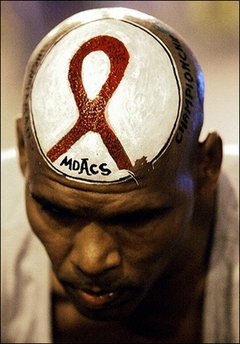Circumcision may cut risk of HIV
(AP)Updated: 2006-12-14 09:30
WASHINGTON - Circumcising adult men may reduce by half their risk of getting the AIDS virus through heterosexual intercourse, the US government announced Wednesday, as it shut down two studies in Africa testing the link.
The National Institutes of Health closed the studies in Kenya and Uganda early, when safety monitors took a look at initial results this week and spotted the protection. The studies' uncircumcised men are being offered the chance to undergo the procedure.
The link between male circumcision and HIV prevention was noted as long ago as the late 1980s. The first major clinical trial, of 3,000 men in South Africa, found last year that circumcision cut the HIV risk by 60 percent.
Still, many AIDS specialists had been awaiting the NIH's results as a final confirmation.
"Male circumcision can lower both an individual's risk of infection, and hopefully the rate of HIV spread through the community," said AIDS expert Dr. Anthony Fauci, director of the NIH's National Institute of Allergy and Infectious Diseases.
But it's not perfect protection, Fauci stressed. Men who become circumcised must not quit using condoms nor take other risks - and circumcision offers no protection from HIV acquired through anal sex or injection drug use, he noted.
"It's not a magic bullet, but a potentially important intervention," agreed Dr. Kevin De Cock of the World Health Organization.
Male circumcision is common at birth in the United States. But in sub-Saharan Africa, home to more than half of the world's almost 40 million HIV-infected people, there are large swaths of populations where male circumcision is rare.
The WHO plans an international meeting early next year to discuss the studies' results and how to translate them into policies that promote safe male circumcision - done by trained health workers with sterile equipment - while teaching men that it won't make them invulnerable.
If male circumcision were widely adopted, officials predicted that could help to avert tens of thousands of HIV infections in coming years; Fauci cited one model from South Africa that suggested possibly up to 2 million infections could be averted over a decade.
"This is tremendous news, and it could help millions of men while in turn reducing the risk faced by millions of women," said Paul Zeitz of the Global AIDS Alliance.
Why would male circumcision play a role? Cells in the foreskin of the penis are particularly susceptible to the HIV virus, Fauci explained. Also, the foreskin is more fragile than the tougher skin surrounding it, providing a surface that the virus could penetrate more easily.
Researchers enrolled 2,784 HIV-negative men in Kisumu, Kenya, and 4,996 HIV-negative men in Rakai, Uganda, into the studies. Some were circumcised; others were just monitored.
Over two years, 22 of the circumcised Kenyans became infected with HIV compared with 47 uncircumcised men, a 53 percent reduction. In Uganda, 22 circumcised men became infected vs. 43 of the uncircumcised, a 48 percent reduction.
The researchers are offering all of the studies' uncircumcised men the chance to undergo the procedure, and 80 percent of the uncircumcised Ugandans already have agreed, said lead researcher Ronald Gray of Johns Hopkins University.
Side effects were rare, including some mostly mild infections that were easily treated. The rate of side effects was comparable to those seen in circumcised US infants, said Robert Bailey of the University of Illinois at Chicago, who led the Kenyan trial.
|
||
|
||
|
|

